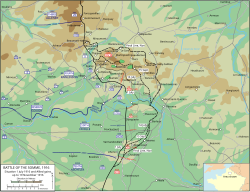Our website is made possible by displaying online advertisements to our visitors.
Please consider supporting us by disabling your ad blocker.
Capture of Mametz
| Capture of Mametz | |||||||
|---|---|---|---|---|---|---|---|
| Part of The Battle of the Somme, First World War | |||||||
 Battle of the Somme 1 July – 18 November 1916 | |||||||
| |||||||
| Belligerents | |||||||
|
|
| ||||||
| Commanders and leaders | |||||||
| Douglas Haig | Erich von Falkenhayn | ||||||
| Strength | |||||||
| 1 division | 1 regiment | ||||||
| Casualties and losses | |||||||
| 3,380 | 2,148 | ||||||
The Capture of Mametz took place on 1 July 1916, when the British Fourth Army attacked the German 2nd Army on the Western Front, during the first day of the Battle of the Somme. Mametz is a village on the D 64 road, about 20 mi (32 km) north-east of Amiens and 4 mi (6.4 km) east of Albert. Fricourt lies to the west, Contalmaison is to the north, Montauban to the north-east and Carnoy and Maricourt are to the south-east. Mametz Wood is 1,000 yd (910 m) to the north-west and before 1914, the village was the fifth largest in the area, with about 120 houses and had a station on the line from Albert to Péronne. During the Battle of Albert (25 to 29 September 1914) the II Bavarian Corps attacked westwards north of the Somme but was fought to a standstill east of Mametz. Reinforced by the XIV Reserve Corps the Germans on the north side of the Somme attacked again and took Mametz on 29 September. After a mutually costly battle for Fricourt, where the French were eventually forced out, the front line stabilised and both sides began to improvise defences. In mid-December a French local attack in the Mametz area was a costly failure.
Mine warfare began soon after a front line was established but the most extensive mining took place further north at La Boisselle. During 1915, the area around Mametz became a comparative backwater. The Germans began systematic fortification of the area, according to a directive from General Erich von Falkenhayn, head of Oberste Heeresleitung the supreme headquarters of the German army, to build defences the Western Front for the fewest infantry to defend the front indefinitely. Later in the year work began on second and third defensive positions. In the Somme area, the defences north of the Bapaume–Albert were improved first and by July 1916 the first position defences around Mametz were extensive but the second position was a shallow trench and the third position had only been marked out.
In June 1916 the British preliminary bombardment cut much of the barbed wire protecting the Mametz defences and destroyed many of the trenches in the first position occupied by Reserve Infantry Regiment 109 of the 28th Reserve Division. When the 7th Division advanced behind a creeping barrage, much of the German front line was quickly overrun and many prisoners taken; delays further forward caused the infantry to lag behind the barrage and suffer far more casualties. Mametz was occupied during the morning by the 20th Brigade but a German counter-attack forced most of the British troops out, until a second attack during the afternoon, when the advance of the 18th (Eastern) Division on the right flank had cut off the Germans in the village from Montauban to the east. The German defence collapsed and the 7th Division reached all of its objectives on the right and in the centre and began to consolidate, ready to receive a German counter-attack.
British and French attacks south of the Albert–Bapaume road continued on 2 July and by 13 July had pushed up close to the German second position through Mametz Wood to the north of Mametz, ready for the Battle of Bazentin Ridge on 14 July, the 7th Division having been relieved by the 38th (Welsh) Division on 5 July. In 1918, the village was recaptured by German troops on 25 March, during Operation Michael, the German spring offensive, when the 17th (Northern) Division, the 12th (Eastern) Division and the 1st Dismounted Brigade of the 1st Cavalry Division were forced to retire to the north-west. Mametz and the vicinity were retaken for the last time on 26 August by the 18th (Eastern) Division and 12th (Eastern) Division.
Previous Page Next Page



